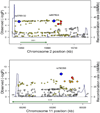A genome-wide association study identifies susceptibility loci for Wilms tumor
- PMID: 22544364
- PMCID: PMC3400150
- DOI: 10.1038/ng.2251
A genome-wide association study identifies susceptibility loci for Wilms tumor
Erratum in
- Nat Genet. 2013 Aug;45(8):962
Abstract
Wilms tumor is the most common renal malignancy of childhood. To identify common variants that confer susceptibility to Wilms tumor, we conducted a genome-wide association study in 757 individuals with Wilms tumor (cases) and 1,879 controls. We evaluated ten SNPs in regions significantly associated at P < 5 × 10(-5) in two independent replication series from the UK (769 cases and 2,814 controls) and the United States (719 cases and 1,037 controls). We identified clear significant associations at 2p24 (rs3755132, P = 1.03 × 10(-14); rs807624, P = 1.32 × 10(-14)) and 11q14 (rs790356, P = 4.25 × 10(-15)). Both regions contain genes that are plausibly related to Wilms tumorigenesis. We also identified candidate association signals at 5q14, 22q12 and Xp22.
Figures

References
-
- Scott RH, Douglas J, Baskcomb L, Huxter N, Barker K, et al. Constitutional 11p15 abnormalities, including heritable imprinting center mutations, cause nonsyndromic Wilms tumor. Nat Genet. 2008;40:1329–1334. - PubMed
-
- Little SE, Hanks SP, King-Underwood L, Jones C, Rapley EA, et al. Frequency and heritability of WT1 mutations in nonsyndromic Wilms' tumor patients: a UK Children's Cancer Study Group Study. J Clin Oncol. 2004;22:4140–4146. - PubMed
Publication types
MeSH terms
Grants and funding
- U24 CA196173/CA/NCI NIH HHS/United States
- 5R01ES011740/ES/NIEHS NIH HHS/United States
- U10 CA98413/CA/NCI NIH HHS/United States
- C8620_A8857/CRUK_/Cancer Research UK/United Kingdom
- MRC_/Medical Research Council/United Kingdom
- 5R01CA133996/CA/NCI NIH HHS/United States
- U10 CA098543/CA/NCI NIH HHS/United States
- WT_/Wellcome Trust/United Kingdom
- U10 CA98543/CA/NCI NIH HHS/United States
- UL1 TR000064/TR/NCATS NIH HHS/United States
- 3P50CA093459/CA/NCI NIH HHS/United States
- C8620/A9024/CRUK_/Cancer Research UK/United Kingdom
- 088804/Z/09/Z/WT_/Wellcome Trust/United Kingdom
- 5P50CA097007/CA/NCI NIH HHS/United States
- DH_/Department of Health/United Kingdom
- U10 CA098413/CA/NCI NIH HHS/United States
- U24 CA114766/CA/NCI NIH HHS/United States
LinkOut - more resources
Full Text Sources
Medical

